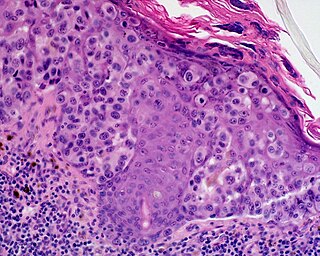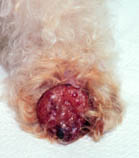
A melanocytic nevus is a type of melanocytic tumor that contains nevus cells. Some sources equate the term mole with "melanocytic nevus", but there are also sources that equate the term mole with any nevus form.
In medicine, Breslow's depth was used as a prognostic factor in melanoma of the skin. It is a description of how deeply tumor cells have invaded. Currently, the standard Breslow's depth has been replaced by the AJCC depth, in the AJCC staging system. Originally, Breslow's depth was divided into 5 stages.

Melanoma, also known as malignant melanoma, is a type of cancer that develops from the pigment-containing cells known as melanocytes. Melanomas typically occur in the skin, but may rarely occur in the mouth, intestines, or eye. In women, they most commonly occur on the legs, while in men they are most common on the back. Sometimes they develop from a mole with changes such as an increase in size, irregular edges, change in color, itchiness, or skin breakdown.

Acral lentiginous melanoma is a kind of lentiginous skin melanoma. Melanoma is a serious skin cancer that arises from pigment cells (melanocytes). Although acral lentiginous melanoma is rare in people with lighter skin types, it is the most common subtype in people with darker skins. Acral lentiginous melanoma is observed on the palms, soles, under the nails and in the oral mucosa. It occurs on non-hair-bearing surfaces of the body, which may or may not be exposed to sunlight. It is also found on mucous membranes. It is the most common form of melanoma diagnosed amongst Asian and sub-Saharan African ethnic groups. The average age at diagnosis is between sixty and seventy years.
Lymphadenectomy or lymph node dissection is the surgical removal of one or more groups of lymph nodes. It is almost always performed as part of the surgical management of cancer. In a regional lymph node dissection, some of the lymph nodes in the tumor area are removed; in a radical lymph node dissection, most or all of the lymph nodes in the tumor area are removed.

A dysplastic nevus or atypical mole is a nevus (mole) whose appearance is different from that of common moles. In 1992, the NIH recommended that the term "dysplastic nevus" be avoided in favor of the term "atypical mole". An atypical mole may also be referred to as an atypical melanocytic nevus, atypical nevus, B-K mole, Clark's nevus, dysplastic melanocytic nevus, or nevus with architectural disorder.

Fine-needle aspiration (FNA) is a diagnostic procedure used to investigate lumps or masses. In this technique, a thin, hollow needle is inserted into the mass for sampling of cells that, after being stained, will be examined under a microscope (biopsy). The sampling and biopsy considered together are called fine-needle aspiration biopsy (FNAB) or fine-needle aspiration cytology (FNAC). Fine-needle aspiration biopsies are very safe minor surgical procedures. Often, a major surgical biopsy can be avoided by performing a needle aspiration biopsy instead, eliminating the need for hospitalization. In 1981, the first fine-needle aspiration biopsy in the United States was done at Maimonides Medical Center. Today, this procedure is widely used in the diagnosis of cancer and inflammatory conditions.

Lentigo maligna melanoma is a melanoma that has evolved from a lentigo maligna. They are usually found on chronically sun damaged skin such as the face and the forearms of the elderly. The nomenclature is very confusing to both patients and physicians alike.
Skin biopsy is a biopsy technique in which a skin lesion is removed to be sent to a pathologist to render a microscopic diagnosis. It is usually done under local anesthetic in a physician's office, and results are often available in 4 to 10 days. It is commonly performed by dermatologists. Skin biopsies are also done by family physicians, internists, surgeons, and other specialties. However, performed incorrectly, and without appropriate clinical information, a pathologist's interpretation of a skin biopsy can be severely limited, and therefore doctors and patients may forgo traditional biopsy techniques and instead choose Mohs surgery. There are four main types of skin biopsies: shave biopsy, punch biopsy, excisional biopsy, and incisional biopsy. The choice of the different skin biopsies is dependent on the suspected diagnosis of the skin lesion. Like most biopsies, patient consent and anesthesia are prerequisites.

Amelanotic melanoma is a type of skin cancer in which the cells do not make any melanin. They can be pink, red, purple or of normal skin color, and are therefore difficult to diagnose correctly. They can occur anywhere on the body, just as a typical melanoma can.
Stereotactic biopsy, also known as stereotactic core biopsy, is a biopsy procedure that uses a computer and imaging performed in at least two planes to localize a target lesion in three-dimensional space and guide the removal of tissue for examination by a pathologist under a microscope. Stereotactic core biopsy makes use of the underlying principle of parallax to determine the depth or "Z-dimension" of the target lesion.

A Mammotome device is a vacuum-assisted breast biopsy (VAC) device that uses image guidance such as x-ray, ultrasound and/or MRI to perform breast biopsies. A biopsy using a Mammotome device can be done on an outpatient basis with a local anesthetic. Mammotome is a registered trademark of Devicor Medical Products, Inc., part of Leica Biosystems.
Microstaging is a technique used to help determine the stage (extent) of melanoma and certain squamous cell cancers. A sample of skin that contains tumor tissue is examined under a microscope to find out how thick the tumor is and/or how deeply the tumor has grown into the skin or connective tissues.
Transperineal biopsy is a biopsy procedure in which a sample of tissue is removed from the prostate for examination under a microscope. The sample is removed with a thin needle that is inserted through the skin of the perineum and into the prostate.
Transrectal biopsy is a biopsy procedure in which a sample of tissue is removed from the prostate using a thin needle that is inserted through the rectum and into the prostate. Transrectal ultrasound (TRUS) is usually used to guide the needle. The sample is examined under a microscope to see if it contains cancer.
Transurethral biopsy is a biopsy procedure in which a sample of tissue is removed from the prostate for examination under a microscope. A thin, lighted tube is inserted through the urethra into the prostate, and a small piece of tissue is removed with a cutting loop.
Needle-localized biopsy is a procedure that uses very thin needles or guide wires to mark the location of an abnormal area of tissue so it can be surgically sampled. An imaging device such as an ultrasound probe is used to place the wire in or around the abnormal area. Needle localization is used when the doctor cannot feel the mass of abnormal tissue.
An open biopsy is a procedure in which a surgical incision (cut) is made through the skin to expose and remove tissues. The biopsy tissue is examined under a microscope by a pathologist. An open biopsy may be done in the doctor's office or in the hospital, and may use local anesthesia or general anesthesia. A lumpectomy to remove a breast tumor is a type of open biopsy.
A fungating lesion is a skin lesion that fungates, that is, becomes like a fungus in its appearance or growth rate. It is marked by ulcerations and necrosis and usually presents a foul odor. This kind of lesion may occur in many types of cancer, including breast cancer, melanoma, and squamous cell carcinoma, and especially in advanced disease. The characteristic malodorous smell is caused by dimethyl trisulfide. It is usually not literally a fungal infection but rather a neoplastic growth with necrosing portions.
Pseudomelanoma is a cutaneous condition in which melantic skin lesions clinically resemble a superficial spreading melanoma at the site of a recent shave removal of a melanocytic nevus.









